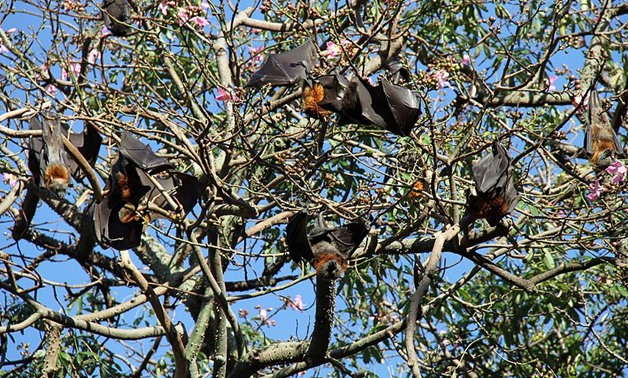
Grey-headed Flying-foxes are believed to be the natural hosts of the NiV, April 7, 2011 - Wikimedia/Greg Schechter
CAIRO – 25 May 2018: The World Health Organization issued a report on Friday warning against an outbreak of the Nipah Virus, NiV, which is transmitted from sick animals, especially fruit bats and pigs, to both humans and animals.
“Nipah virus is an RNA virus that is part of the Paramyxovidae family that was first identified as a zoonotic pathogen after an outbreak involving severe respiratory illness in pigs and encephalitic disease in humans in Malaysia and Singapore in 1998 and 1999,” according to the WHO’s website.
Time reports that during its first outbreak in Malaysia nearly 300 farmers became infected and more than 100 died. “To stop the outbreak, authorities had to euthanize over one million pigs. Since then, the virus has been identified in outbreaks in Bangladesh and India,” Time reports.
“In the Bangladesh and India outbreaks, consumption of fruits or fruit products (e.g. raw date palm juice) contaminated with urine or saliva from infected fruit bats was the most likely source of infection,” the WHO explains.
The U.S. Centers for Disease Control and Prevention (CDC) report that the disease occurs in Bangladesh on an annual basis, Time states.
Currently, the disease has broken out in Kerala, a southern state in India, and 10 deaths have been caused by it to date, according to Time.
Symptoms
The WHO reports that the symptoms usually take between five to 14 days to manifest.
“Infected people initially develop influenza-like symptoms of fever, headaches, myalgia (muscle pain), vomiting and sore throat. This can be followed by dizziness, drowsiness, altered consciousness, and neurological signs that indicate acute encephalitis. Some people can also experience atypical pneumonia and severe respiratory problems, including acute respiratory distress. Encephalitis and seizures occur in severe cases, progressing to coma within 24 to 48 hours,” WHO reports.
The WHO also states that most people make full recoveries from the disease, but 20 percent of survivors face a lifetime of neurological consequences such as seizures and personality changes.
The death rate is between 40 and 75 percent, depending on the outbreak, and local capabilities to deal with the outbreak.
Cure
There is no cure for the Nipah virus.


Comments
Leave a Comment